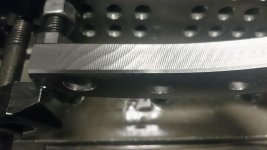shimmwagen
Plastic
- Joined
- May 7, 2008
- Location
- sardis bc
trying a new cutter out, walter prototyp AH3021138-3/4, 8 flute solid carbide endmill. cutting a 16" half circle/8" radius in a cast iron part, machine is a daewoo dhm500. approximately .200" of material coming off. manufacturer recomended this-----S= 4400 RPM... sfm of approx 860 based on structural steel 44W / A36 / 1015 F= 352 IPM... ----- we ran it at this and we could barely hear the cutter, nice chips coming off and the size was dead on. the strange thing is that we got feed lines on the surface, almost looked like a zip tie/zap strap! we slowed down feed into the 100's which shortened up the lines but they were still there... any one have experience with these endmills?? all the math works out for depth of cut and speed/feed. the tool rep thinks maybe the machine can't keep up with the code but i am just using a g3 to make the arc...
this is the current solid carbide code im using, i just changed speed/feed accordingly for the walter endmill...
(FINISH 7.811 RADIUS)
(HOLD SIZE TO 15.62 +.01/-0)
N3T53M6(T3-H194)(.75 FINISH ENDMILL)
T55
G54G90G94G0X-3.1Y-6.4375B0
S800M3
G43Z3.0H194
Z1.
M8
G1Z-1.1F40.
G41Y-7.4375D194
X0.F13.
G3Y7.4375J7.4375
G1X-3.1
G40Y6.4375
G0Z1.
M9
G91G28Z0.M5
G91G28X0.Y0.
M1
any thoughts/suggestions would be appreciated.
glenn
this is the current solid carbide code im using, i just changed speed/feed accordingly for the walter endmill...
(FINISH 7.811 RADIUS)
(HOLD SIZE TO 15.62 +.01/-0)
N3T53M6(T3-H194)(.75 FINISH ENDMILL)
T55
G54G90G94G0X-3.1Y-6.4375B0
S800M3
G43Z3.0H194
Z1.
M8
G1Z-1.1F40.
G41Y-7.4375D194
X0.F13.
G3Y7.4375J7.4375
G1X-3.1
G40Y6.4375
G0Z1.
M9
G91G28Z0.M5
G91G28X0.Y0.
M1
any thoughts/suggestions would be appreciated.
glenn





